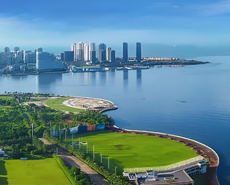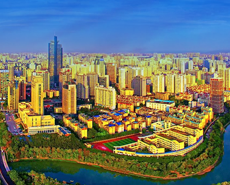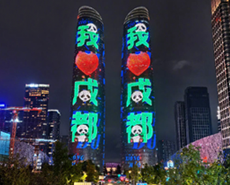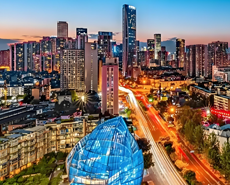Manatrade AG, insights and the future of the cobalt industry
----Interview with trading & product manager Sam Wang from Manatrade AG
Manatrade AG is located in Switzerland and was founded in 2006 and is the marketing and trading arm of Managem Group, which is the biggest private mining group in Morocco. Manatrade AG is in charge of the marketing and sales of all Managem’s mineral and hydrometallurgical products, such as: gold, silver, zinc concentrate, copper concentrate, lead concentrate, fluorspar, arsenic trioxide, zinc oxide, iron ore, nickel intermediate and cobalt metal.
Asian Metal: Good morning Mr Wang and thank you very much for accepting this interview. Firstly, could you please give us a brief introduction of your role inside Manatrade AG and what Manatrade AG does?
Mr Wang: Good morning Martim and thank you very much for the invitation. As you know I am the head of trading and the product manager of hydrometallurgical products at Manatrade AG; being in charge of the marketing and sales of cobalt metal, arsenic trioxide, zinc oxide, nickel intermediate, iron ore fines, sulfuric acid and other hydro products.
Manatrade AG is a fully-owned marketing subsidiary of Managem Group, the biggest private mining group in North Africa. We are handling and managing marketing strategies and sales planning of all the mineral material from Managem Group’s subsidiaries like Akka, SMI, CMG, CTT, etc. Therefore, Manatrade AG is a very famous supplier of precious metal, copper, lead, zinc concentrate, fluorspar, nickel intermediate, cobalt metal, and other hydrometallurgy material to worldwide markets. At same time, Manatrade AG is in charge of the distribution and sales of the annual output of 2,000mt of CMBA brand cobalt broken cathode produced by our sister company, CTT in Morocco.
Asian Metal: Interesting, so Manatrade AG is a sister company of CTT and is in charge of CTT’s cobalt sales, could you please tell us a little bit about CTT?
Mr Wang: In 1928, CTT started our cobalt mining activities in Bou Azzer, which is one of the oldest cobalt mines in the world. CTT Cobalt ore is also the only cobalt primary mine in the world unlike other cobalt ores such as nickel-cobalt ore or copper-cobalt ore. In the past, CTT exported its cobalt concentrate to China and other markets. However, since 1996 CTT started its own hydrometallurgical plant to produce cobalt broken cathode metal in Marrakech. Nowadays, CTT ‘s capacity is around 2,000mt of 99.8% cobalt metal, 2,500mt nickel intermediate and 8,000mt 99.5% high grade arsenic trioxide per year. Therefore, CTT is a very important producer of cobalt broken cathode as well as a main supplier in the arsenic trioxide market.
Asian Metal: Is cobalt the main product of CTT?
Mr Wang: Yes, cobalt metal is the most important CCT product, producing cobalt broken cathode, which is the most consumed form of cobalt by the catalyst, magnet and hard alloy industries. Besides Cobalt broken cathode, CTT also produces gold, silver blister, arsenic trioxide, nickel intermediate, sulfuric acid and iron ore in its hydrometallurgical plant in Marrakech. CTT raw material comes all from Bou Azzer mine which is next to Ouazazate area in Morocco. Moreover, CTT also operates a sulfuric plant to treats the iron pyrrhotite tails from CMG - another Managem’s subsidiary - to generate sulfuric acid and energy for CTT’s hydrometallurgical plant’s usage.
Asian Metal: Thank you very much Mr Wang for these very interesting insights, but what about the market, which are the main applications of cobalt in the market?
Mr Wang: Cobalt is widely consumed in Li-ion batteries, NiMH and NiCd batteries, super alloys, hard alloys, magnets, catalysts, ceramics, painting, animal feed, and many other chemical applications. However, lithium batteries and metallurgy alloys (super alloys and hard alloys) are the major two applications for cobalt.
The cobalt output has increased in the world market over the past two years due to the new projects of copper and nickel who now produce cobalt as a by-product. It turned the cobalt market into oversupply during 2014 and 2015 and brought a lot pressure for cobalt market participants. In 2016, the cobalt market is turning to deficit again due to the increasing demand in metallurgy alloys and Li-ion batteries for EV while some cobalt producers have stopped production such as Tocantins and Katanga.
Asian Metal: However, CTT is not the only brand in the market, which other brands would you identify in the market?
Mr Wang: The cobalt metal market has four types of cobalt produced by 15 companies: (i) cut cathode; (ii) broken cathode; (iii) briquettes and powder; (iv) ingot and round. There are six cut cathode producers in the world, which are Falconbridge, Sumitomo, Jinchuan, KLK, Cash and new Norilsk. Regarding the broken cathode there are two producers, CTT and Chambishi. Moreover, the briquette and powder producers are 5, Sherritt, Ambatovy, Murrin Murrin, Impala and Freeport Cobalt. And finally, the Ingot and round producers are two, Inco and Norilsk (Norilsk already changed their production to cut cathode in 2016).
Asian Metal: If you had to identify the main industries that consume the cobalt broken cathode produced by CTT which would be the top 3?
Mr Wang: CTT cobalt broken cathode has much lower nickel and copper contents comparing to other cobalt metals produced from copper and nickel mines. CTT cobalt is well-known for its good and stable quality among all the brands of broken cathodes. Many cobalt end users even prefer CTT cobalt metal which is of Moroccan origin because users like to diversify their cobalt purchasing sources. Now, if I had to pick three top consumers of CTT cobalt broken cathode I would say the catalyst, hard alloys and batteries industries.
Asian Metal: That leads me to my next question. We have been seeing prices booming over the past weeks or even months, what would you think to be the main reasons behind the higher prices? Are there any specific industries pushing the cobalt prices up?
Mr Wang: The strong demand in Li-ion battery for EV is the main factor for the increasing in the cobalt prices during 2nd half of 2016. The battery demand has rose by 12% every year in the past years and the worldwide EV annual production is forecasted to increase 600% by 2025. We have been seeing the EV manufacturers and Li-ion battery producers trying to secure the raw material and locking big volume of cobalt out of the market over the past months; what has been adding pressure on the current market prices and creating issues of cobalt supply with supply currently not being able of fulfilling the world total demand.
At the same time, cobalt supply quantity is no longer increasing like in the past because of low copper and nickel prices. Currently there are less and less new nickel and copper projects being commissioned therefore the world cobalt supply is anticipated to remain unbalanced with respect to the world total demand, anticipating a supply deficit in the cobalt world market in the coming years.
In addition, some non-traditional market participants such as hedge funds and investment institutions have shown a big interest to invest in the cobalt business during 2016. They have been trying to lock physical cobalt stocks or even trading in the LME. The entry of such non-traditional market participants has fuelled the uptrend in the cobalt prices over the past months reinforcing the strong demand for cobalt already seen in the battery sector.
Asian Metal: What if we look with more detail to the battery industry, a hot topic these days, would you think that this could be the main cobalt market in the future?
Mr Wang: Indeed. The cobalt consumption in battery is more than 45% of overall cobalt consumption and this ratio is anticipated to increase within the following years because of the strong growth of the EV and storage batteries for sustainable energy. Therefore, battery industry and its value chain will play and is already playing a very important role for cobalt market.
Nowadays, using green energy or sustainable energy has attracted people’s attention. It is one of the solutions against the global warming and to reduce air pollution. In the Conference of Paris, countries have reached an agreement to control the global warming problems by signing even stronger commitments and we believe that the EV cars and the sustainable energy storage batteries will keep booming in China, Europe and the US because of the new commitments. The battery sector is definitely the potential main cobalt market in the near future.
Asian Metal: Really? What about the Tesla Gigafactory and its impact in the industry? Do you think that Tesla will become one of the main consumers of cobalt in the world?
Mr Wang: Definitely, in the documentary film distributed by the National Geographic, “Before the Flood”, you can see Leonardo DiCaprio having a conversation with Elon Musk about Tesla's Gigafactory and how Mr Musk explains how the world could make the transition from fossil fuels to renewable energy with such technology. It really inspires people to think about how the renewable and sustainable energy could save our world. Therefore, I believe that the Li-ion batteries are indeed the main alternative that we currently have to store energy and promote a more sustainable world.
Moreover, not only Tesla has such strong ambition to develop sustainable energy. There are many other companies also devoted to rechargeable batteries for electronic applications and electronic vehicles in Europe, Korea, Japan, and China. LG, Samsung, Panasonic, BYD, ATL and CATL are some of other companies who are involved with similar technologies and initiatives. I do honestly believe that the development of the rechargeable batteries market and technology is going to be faster than people expected; and this will bring a new era for the cobalt industry.
Asian Metal: Mr Wang it was a real pleasure speaking with you as always and thank you very much for your time once again. Would you like to add anything to our conversation?
Mr Wang: It is my great pleasure. Yes, if I can I would like to speak briefly about the CDI 2017 conference that will be held in the city of Marrakech in Morocco. We highly welcome everyone from cobalt industry to visit us in Marrakech. The Government of Morocco has decided to exempt Chinese nationals from visa requirements to enter Morocco starting from June 2016. Therefore, it is very convenient for Chinese visitors and delegates to visit Morocco not only because of the CDI 2017 conference but also because it is now easier to enter in the country to make business.
















